2.0 Laptop and Portable Devices
2.1 Identify the fundamental principles of using laptops and portable devices
Peripherals (e.g. docking station, port replicator and media / accessory bay)
1. Docking Station:
A docking station is a desktop extension of a portable computer that remains on a desk. The portable notebook hardware functionality is limited to make it viable to be used in mobile environment. But, when you go back to home or office, you may want to use the laptop in a similar way as that of a desktop computer. To accommodate extended functionality, you require a docking station. Docking stations are used to extend the functionality of light-weight portable laptops so that it is more of a desktop replacement, for use at home. Docking stations provide additional ports as well as slots for inserting modules such as hard disk or a CDROM drive. A docking station typically support devices like: hard drive bays, optical drive bays, keyboard/mouse connectors (PS/2 ports), additional USB ports, PC Card slots, external display connectors, and others. The primary difference between a docking station and a port replicator is that the former will have both additional ports as well as bays to insert additional (spare) components whereas the latter will have only additional ports. Given below is a docking station from IBM.
Note that most of the docking stations are product specific, meaning that they support only a given set of laptop makes. There is no vendor neutrality. Therefore, when you buy a docking station, ensure that it is compatible with your laptop computer.

Port Replicator:
Usually, a notebook computer will have limited I/O ports due to compact design. A port replicator provides additional I/O ports for adding additional devices such as a printer or a scanner. You can attach a laptop to a port replicator to provide much needed additional ports. A typical port replicator diagram is shown below:

As can seen from the figure above, a port replicator will have external ports for connecting a monitor, mouse, keyboard, modem, network card, printer, etc.
Disclaimer: Simulationexams.com is not affiliated with any certification vendor, and Sim-Ex™ Practice Exams are written independently by SimulationExams.com and not affiliated or authorized by respective certification providers. Sim-Ex™ is a trade mark of SimulationExams.com or entity representing Simulationexams.com.A+™ is a trademark of CompTIA® organization.